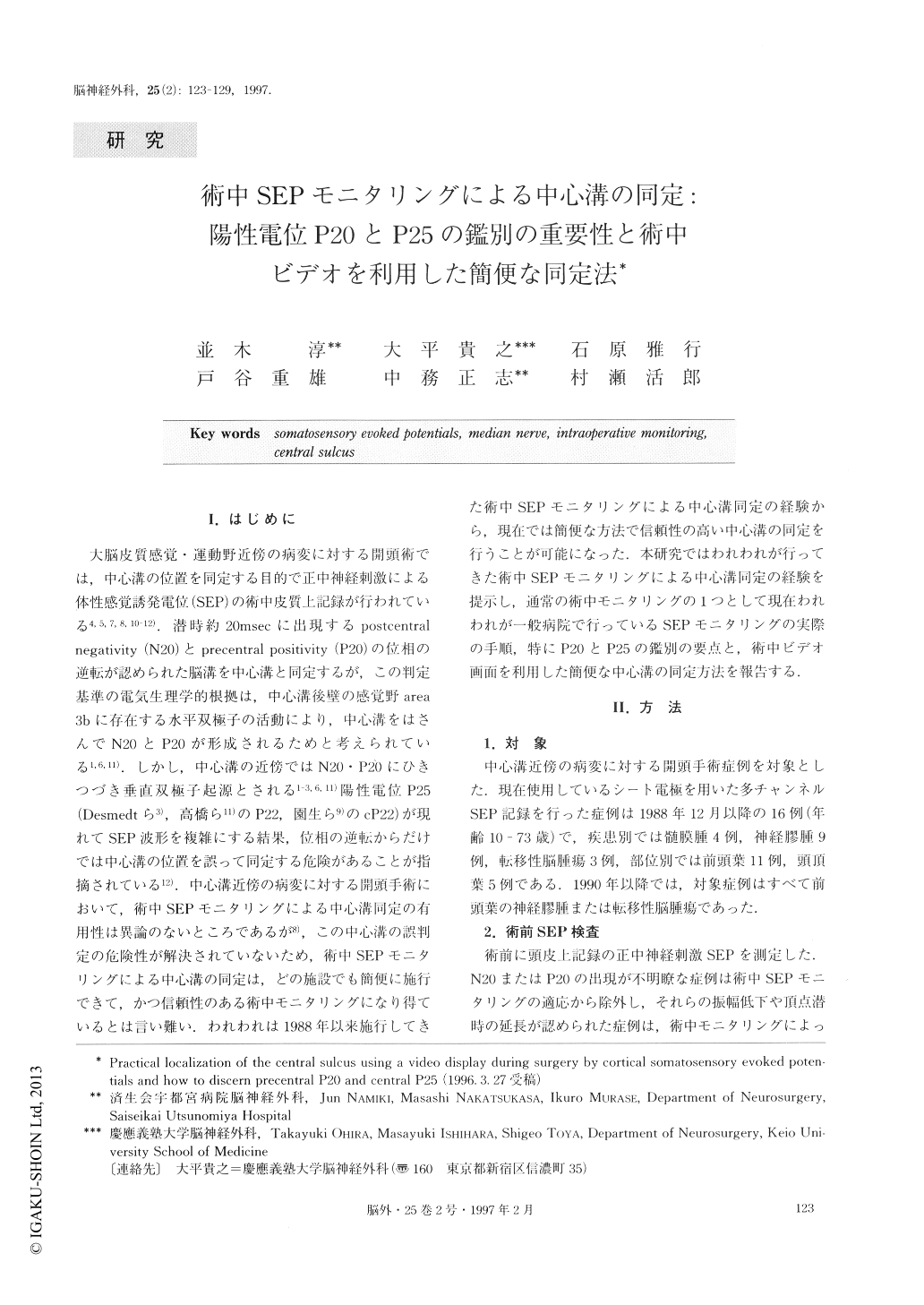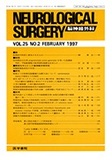Japanese
English
- 有料閲覧
- Abstract 文献概要
- 1ページ目 Look Inside
I.はじめに
大脳皮質感覚・運動野近傍の病変に対する開頭術では,中心溝の位置を同定する目的で正中神経刺激による体性感覚誘発電位(SEP)の術中皮質上記録が行われている4,5,7,8,10-12).潜時約20msecに出現するpostcentralnegativity(N20)とprecentral positivity(P20)の位相の逆転が認められた脳溝を中心溝と同定するが,この判定基準の電気生理学的根拠は,中心溝後壁の感覚野area3bに存在する水平双極子の活動により,中心溝をはさんでN20とP20が形成されるためと考えられている1,6,11).しかし,中心溝の近傍ではN20・P20にひきつづき垂直双極子起源とされる1-3,6,11)陽性電位P25(Desmedtら3),高橋ら11)のP22,園生ら9)のcP22)が現れてSEP波形を複雑にする結果,位相の逆転からだけでは中心溝の位置を誤って同定する危険があることが指摘されている12),中心溝近傍の病変に対する開頭手術において,術中SEPモニタリングによる中心溝同定の有用性は異論のないところであるが8),この中心溝の誤判定の危険性が解決されていないため,術中SEPモニタリングによる中心溝の同定は,どの施設でも簡便に施行できて,かつ信頼性のある術中モニタリングになり得ているとは言い難い.われわれは1988年以来施行してきた術中SEPモニタリングによる中心溝同定の経験から,現在では簡便な方法で信頼性の高い中心溝の同定を行うことが可能になった.本研究ではわれわれが行ってきた術中SEPモニタリングによる中心溝同定の経験を提示し,通常の術中モニタリングの1つとして現在われわれが一般病院で行っているSEPモニタリングの実際の手順,特にP20とP25の鑑別の要点と,術中ビデオ画面を利用した簡便な中心溝の同定方法を報告する.
In patients with lesions around the central sulcus, cortical surface somatosensory evoked potentials (SEPs) have been applied for the purpose of localiza-tion of the central sulcus based on the polarity inver-sion of postcentral N20 to precentral P20 across the central sulcus. We have intraoperatively monitored SEPs to infer the location of the central sulcus in 16 cases since December 1988. Intraoperative localization of the central sulcus has been most useful in patients with frontal lobe gliomas in which the localization of the central sulcus enables the surgeon to extensively re-sect tumor without postoperative motor weakness. The localization of the central sulcus, however, might be misjudged by using the polarity inversion criterion alone, because central P25 following N20 and P20 com-plicates SEP waveforms. It is significant that P25,which is recorded also posterior to the central sulcus, is discerned from the precentral P20. In order to solve this matter, we regarded only the positivity in SEP waveforms having the identical peak latency to that of N20 as the precentral P20. Positive potentials having a later peak latency than that of N20 are the superposi-tion of P20 and P25, and might also be recorded post-erior to the central sulcus.
For the observation of the polarity inversion of N20 to P20 across the central sulcus, a multi-channel SEP should be recorded using a sheet of silicone rubber embedded in a 16-electrode array consisting of a 4 by 4 grid. We projected the exposed cortical surface on the video display through the microscope apparatus and marked the locations of the recording electrodes on the video display. This enabled the location of the record-ing electrodes to correspond easily and precisely to the cortical surface.
Our reliable and simple method of intraoperative localization of the central sulcus by cortical SEPs moni-toring is presented in a practical case.

Copyright © 1997, Igaku-Shoin Ltd. All rights reserved.


